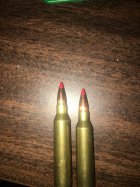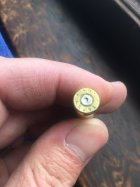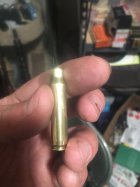Majday
Silver $$ Contributor
First I’ll say I’ve been reloading very basically for 20 years on a single stage rcbs. I clean, fl size, chamfer, deburr, load. Pretty basic. I may shoot a couple hundred centerfire rounds a year. I have general knowledge but not like many of you have.
I have a 20 p that has less than 200 rounds through it. It’s a hart barrel not sure on twist- I’d guess a 10 or 11 as t shoots 40vmax well. Ruger mk2 action. I size brass with Redding fl type s using .233 down to 226 and 223. I generally use a 1/4 turn more once the die contacts the shell holder.
I have two questions that may not answered with just a straight up do this or that.
1- when using the same LC92 brass going through the same steps to form I come across some brass that cycles perfect (non loaded) and some that gets stuck in the chamber and I have to punch it out. Is there a reason for this? I’ve tried turning the die down more to adjust for bumping the shoulder back more but that helps minimally. Ideally a 20 p doesn’t need to fire form to the barrel right? I get some slight vertical marks up the brass from sizing as well. I’ve had fired rounds that seem to cycle better after been fired once and other that don’t. I’m stumped.
2- I have some loaded rounds that shoot great. About 1/2in at 100. 25gr benchmark and 205m at coal of 2.260. Once a round goes into the chamber, I see marks on the bullet that seem to be contacting the rifling. I don’t believe this is normal. Would it be best to seat the bullet a little deeper? I haven’t had any problems with the accuracy and pressures are ok. Slight cratering on the primers but nothing to be alerted about I don’t believe. If there is any other info that may help let me know.
Thanks for any help
Jameson
I have a 20 p that has less than 200 rounds through it. It’s a hart barrel not sure on twist- I’d guess a 10 or 11 as t shoots 40vmax well. Ruger mk2 action. I size brass with Redding fl type s using .233 down to 226 and 223. I generally use a 1/4 turn more once the die contacts the shell holder.
I have two questions that may not answered with just a straight up do this or that.
1- when using the same LC92 brass going through the same steps to form I come across some brass that cycles perfect (non loaded) and some that gets stuck in the chamber and I have to punch it out. Is there a reason for this? I’ve tried turning the die down more to adjust for bumping the shoulder back more but that helps minimally. Ideally a 20 p doesn’t need to fire form to the barrel right? I get some slight vertical marks up the brass from sizing as well. I’ve had fired rounds that seem to cycle better after been fired once and other that don’t. I’m stumped.
2- I have some loaded rounds that shoot great. About 1/2in at 100. 25gr benchmark and 205m at coal of 2.260. Once a round goes into the chamber, I see marks on the bullet that seem to be contacting the rifling. I don’t believe this is normal. Would it be best to seat the bullet a little deeper? I haven’t had any problems with the accuracy and pressures are ok. Slight cratering on the primers but nothing to be alerted about I don’t believe. If there is any other info that may help let me know.
Thanks for any help
Jameson
Attachments
-
 9930ECB7-3EE6-42C7-A5FE-219344D1B26B.jpeg613.9 KB · Views: 95
9930ECB7-3EE6-42C7-A5FE-219344D1B26B.jpeg613.9 KB · Views: 95 -
 8855FE20-D0C6-4887-A6EC-AFA6850D5E34.jpeg433 KB · Views: 90
8855FE20-D0C6-4887-A6EC-AFA6850D5E34.jpeg433 KB · Views: 90 -
 4A3ABB91-432E-4F1E-B934-333ABBA837F8.jpeg274.1 KB · Views: 85
4A3ABB91-432E-4F1E-B934-333ABBA837F8.jpeg274.1 KB · Views: 85 -
 1C7EF82C-A049-4839-AF39-A3950A7199AE.jpeg288.2 KB · Views: 87
1C7EF82C-A049-4839-AF39-A3950A7199AE.jpeg288.2 KB · Views: 87 -
 CD53AE41-FC54-4184-85F9-CBD0A0B05C14.jpeg326.3 KB · Views: 93
CD53AE41-FC54-4184-85F9-CBD0A0B05C14.jpeg326.3 KB · Views: 93












